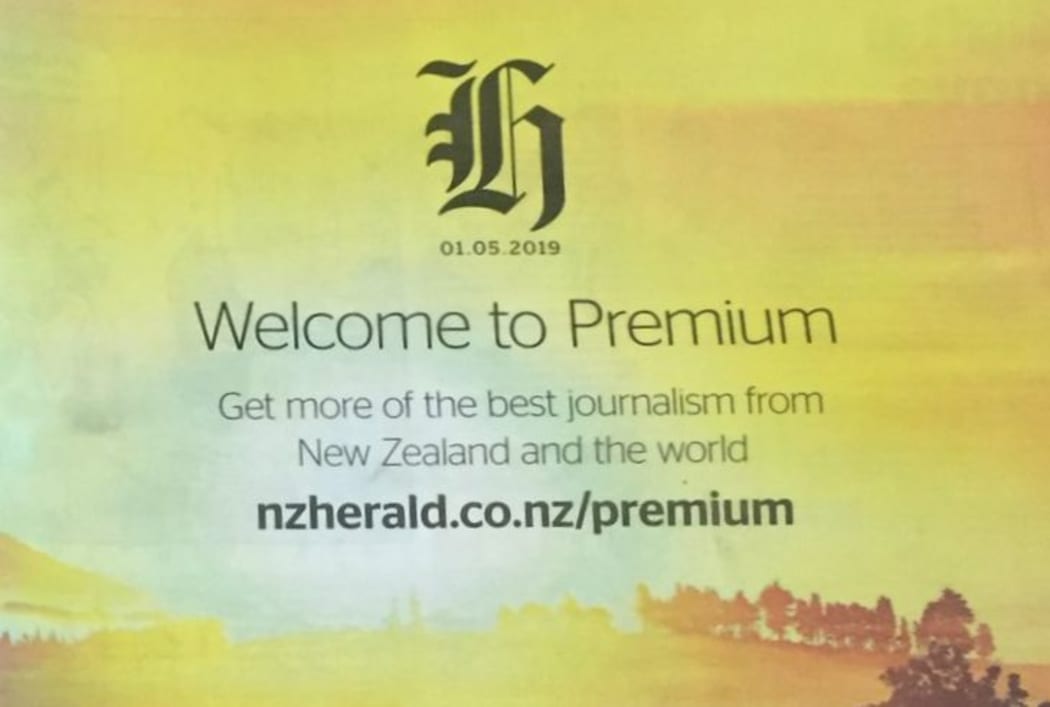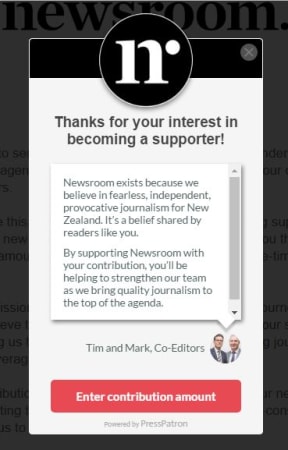For years, the country’s top-selling paper talked about making online readers pay - just like subscribers to the printed paper. This week The New Zealand Herald finally did it. The ads they once monopolised are dwindling so it makes sense to seek more revenue from the readers. But will they now cough up to cover the cost of quality reporting?

The Herald gives its readers the message that its time to cough up online for the best bits. Photo: PHOTO / RNZ Mediawatch
The free ride is over for people who’ve been getting the best - and costliest - journalism from The New Zealand Herald online for nothing for years.
The Herald’s publishers had talked about putting up a paywall since 2011 but didn't do it largely for fear of losing readers to its online rival Stuff.
On the Herald's sister radio network Newstalk ZB this week, the Herald’s managing editor Shayne Currie said it was bringing in online subscriptions 20 years too late.
At a journalism conference two years ago, Currie even said it was might be too late to change that.
"We made some big mistakes as an industry 20 years ago when we made all our content available free. But there’s no going back in my view,” he said in 2017.
Last year NZME chief executive Michael Boggs said they would start charging for premium content by the end of 2018 but that deadline came and went.
But this week NZME unveiled a price of $5 a week or $199 a year - and the yellow 'premium content' tags appeared last Tuesday on many of the stories on the Herald’s homepage.
On Tuesday those included a power ranking of local companies' directors; ratings of the governing coalition’s ministers and a scoop about about a diplomat caught at customs holding $300,000 in cash.
“There’s plenty more where that came from for our premium subscribers,” Currie declared bullishly.
Later in the day there was a fresh story billed as the biggest rugby story of the week, one promising to reveal the "staggering amount of meth Kiwis take every day", and another about the tantalising prospect for motorists up north of 200km of motorway through Auckland from Warkworth to Cambridge.
There were also the stories you don't need to pay to read: The biggest loser from the rift between Princes William and Harry and 'I trust Judith' says Simon Bridges.
The Herald's digital subscribers will also have access to selected articles from the New York Times, the Financial Times, Harvard Business Review and The Times in the UK, which all run their own paywalls for their own subscribers too.
The stakes are high - and not just for the Herald. Back in February, NZME's Michael Boggs said the very future of journalism depended on this.
His target is 10,000 subscribers within the next year, and to convert 4-5% of the current online audience into subscribers by 2021.
One challenge will be keeping up the flow of premium content beyond the initial two-month period of discounted access. The Herald has a limited pool of senior journalists to draw on and, unlike the big overseas publications running paywalls, a limited range of 'premium' local issues to cover.
"We have to produce the journalism that the audience values and that’s the stuff that takes time and investigative work," Herald premium content editor Miriyana Alexander told Mediawatch.
"Up until now we’ve been in a race to get 'mass eyeballs' on the site but anyone with half an eyeball on the industry knows that the economics of media have been eroded. We will never be bigger than Facebook and Google and we won’t attract the digital advertising dollars that they do," she said.

The Herald's premium team: Murray Kirkness, Shayne Currie, Miriyana Alexander. Photo: supplied NZ Herald
After editing the Weekend Herald, she went to Cambridge University last year to research overseas news organisations and their digital transitions.
"What was heartening was that people are prepared to pay for quality journalism. The Guardian this week announced and incredible financial turn around - and it’s down to their subscriptions driven by the membership model," she said.
After years of losses sustained by the non-profit trust bankrolling The Guardian, the publisher announced last week reader revenue put it back in the black. But this has been done by appealing to readers worldwide for contributions and not putting up a paywall.
"The point is that reader revenue for some global publishers is now outstripping commercial revenue. It’s not necessarily great because commercial revenue is vital but there are trends that audiences are prepared to pay," said Alexander.
One hurdle is that the Herald online has been serving up heavy diet of clickbait for years.
"It appears that they will be trying to sell the New York Times behind the front page of the Daily Mail," said The Spinoff, recently summing up the dilemma.
The Herald also serves as a promotional tool for sister radio station Newstalk ZB. The on-air opinions of its broadcasters who lean heavily to the right are re-published by the Herald to maximise their exposure.
It sits awkwardly alongside the Herald's investigative reporting and impartial journalism. It also turns off readers who don't like the partisan approach or share the same politics.
Miriyana Alexander denies the nzherald.co.nz is a promotional tool for Newstalk ZB and its personalities. She says no-one in the audience research they conducted indicated they would be unwilling to subscribe because of the prominence of ZB's radio hosts.
Will Herald readers cough up to boost the Herald’s coffers for journalism?

Press Patron's Alex Clark speaking at the Journalism Still Matters Summit in Parliament. Photo: RNZ / Jeremy Rose
Alex Clark is the chief executive founder of PressPatron, an online platform connecting outlets offering public interest journalism with readers willing to pay for it. It's used by a range of small self-published blogs, substantial online news services like Newsroom.co.nz and even the country's biggest magazine publisher Bauer Media.
Mr Clark's starting point was to ask people in 2014 what they would be prepared to pay for news online - and how much.
"We found people were willing to make a voluntary contribution to support journalism but some people were not prepared to pay for journalism locked up behind a paywall. Since we launched, our successful publishers are converting between 1 and 5 per cent of their monthly unique audience," he said.
Alex Clark says half the people opt into monthly contributions and the other half opt for one-time contributions. The average recurring contribution is $11.40 per month and one-time contributions average out at just over $49.

This is the pitch newsroom.co.nz readers see if they click on Press Patron's to "become a supporter" button. Photo: screenshot
"Hopefully the Herald gets people to pay because it's important but ... they may have had more success if they just asked readers without putting up the barriers," he said.
"What guarantee is there the $199 a year will go to supporting quality journalism, and not instead be used to pay off debt or dividends for owner NZME and its investment fund shareholders?" former Herald editor Tim Murphy asked on Newsroom.co.nz, the site he now co-edits.
"This is definitely about journalism. I'm spending time with the CEO Michael Boggs ... and we have talked about employing more journalists with the new money coming in the door. I won't let him forget about that" Miriyana Alexander told Mediawatch.
"Companies like the New York Times and Washington Post have hired a lot of journalists and if you see the company is really giving the journalists the space to do investigative reporting - and there are great reporters at the Herald - I think that’s where the value proposition is for people willing to pay," said Merja Myllylahti, co-director of AUT’s Centre for Journalism Media and Democracy.

AUT’s School of Communication Studies Research Fellow Dr Merja Myllylahti. Photo: supplied
She studies how paid news content online boosts media revenues, what kind of content works behind paywalls, and how media companies attract and retain subscribers.
She told Mediawatch several established newspaper mastheads overseas, like the Herald, have opted for the 'freemium' model - a mix of free and subscriber-only content on the same site - but attracting subscribers at launch is just the beginning.
"Keeping the people is also very costly we have seen at the New York Times for example the marketing budget has ballooned because they have to keep these people coming back to them to renew their payments. A lot of people take the offer for a couple of months. The challenge is to get them subscribing again," she said.
"Around the world you see that people sign up and sometimes you get cancellation rates of up to 40, 50 and 60 per cent after three to six months. That’s a lot of people being lost," said PressPatron's Alex Clark.
"But with a voluntary model the retention is very high ... because people have opted in at a price point that matches their budget. After 12 months you might still have 85 to 90% of your subscribers from a year ago," he said.

